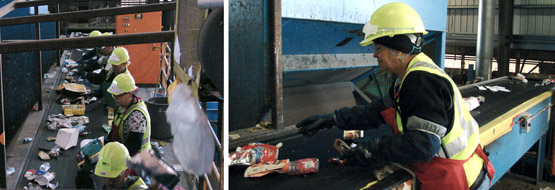New State-of-the-Art Recycling Facility Ups the Ante on Efficiency

Photo by Eva Mojica
By Michelle Slade
Published: May, 2007
Tucked away at the very end of a busy, light-industrial street in San Leandro is the Davis Street Station for Material Recycling and Transfer, a recycling division of Waste Management. It sits on a landfill that once butted up against the water at the top end of the Alameda Estuary, now known as Oyster Point Regional Park. Efficiency is the name of the game at Davis Street, and that game has just taken on a new player in the form of a state-of-the-art $9 million single-stream recycling facility, one of the most modern of its kind operating in the United States today.
This new machine facilitates the complicated sorting process of organizing recyclable products such as newspaper and soda bottles, and weeding out that which does not qualify as recyclable such as diapers, shoes and bowling bowls (yes, you read that correctly). About 10 percent of material that arrives at Davis Street in recycling cans is not recyclable. As a result, recycling garbage has to be hand sorted. Now, with the new machine, a whopping 400 tons of recycling garbage can be sorted daily, much of which previously had to be hand sorted and consequently would end up in the landfill.
Since 1989, itís been state law that every city must divert from landfills a growing percentage of its total garbage collected; therefore, itís been imperative to educate communities on how to recycle. Cities are held accountable to this law with fines of up to $10,000 per day imposed for non-compliance.
But itís not so easy, as Rebecca Jewell, Recycling Programs Manager for Waste Management, explains: Itís common to find the can for organics and composting to be filled with something like polystyrene popcorn, and vice versa, green organics in the black garbage cans. We have absolutely no way of knowing what is in which can, so often times, more garbage than necessary ends up at the landfill. People need a better understanding of what can and cannot be recycled.
Fortunately, the new facility will lessen the publicís confusion with recycling as it allows for all recyclables to go in just one can, with the exception of organics. Upon arrival at Davis Street, recyclable mixtures now enter an efficient single stream for sorting both mechanically and by hand. The goal is to have at least 90 percent of like material sorted together. It takes 36 sorters working day shift and 32 sorters on swing shift to pull off one to 2.5 tons of material per shift each day.
Profitable waste
In particular, plastic products have long been the curse of recycling facilities. Waste Management is required by contract to accept every kind of plastic at the single stream facility even though many plastics arenít as recyclable as others (i.e. yogurt tubs). This is in part due to the low petroleum content and the high costs of recycling particular materials.
Understanding that recycling must be profitable in order to be sustainable, Waste Management researched what they could do with difficult-to-recycle plastics that inevitably make their way to the single stream. The answer was to mix it with injected plastics that come from industrial lines such as milk crates, garbage cans, kidsí toys and anything Rubber Maidģ ever made.
As a result, the new single stream facility now pulls off all plastics and mixes it with the plastics coming off the construction and demolition sorting facility. As an act of stewardship following a request from the City of Alameda, Davis Street has separated out these plastics since September 2006 and now 3,000 to 5,000 new tons of plastic per day are sent for recycling.
Sadly, the majority of this plastic ends up in China where it simply gets recreated and shipped back out as another plastic product. Relevant is the fact that the postage stamp on a container shipped to China is about $300, seemingly inexpensive for a 50 cubic yard (or 1,000 square feet, basically the size of an apartment), container to travel that distance. Once there, and labor being as it is in China, itís dirt cheap to hire someone to sort the plastics into various grades. And the cost of shipping that same container back to the United States is more like $3,000.
Jewell hopes that the value of recycled plastics will one day be such that it will become feasible to process and re-use domestically.
Back at Davis Street, Jewell advises on general pain-in-the-butt products that make life difficult for the human sorters. Plastic bags are the most common, problematic substance, followed by Ďwrapablesí such as hoses, Christmas lights, ribbon, stringy plastic etc., stuff that can shut the equipment down very quickly.
Jewell also asks that people donít fill plastic bags with recyclables and tie them shut as thereís no time to untie them to see whatís inside once itís on the recycling belt speeding past at 50 feet per minute. Itís also helpful if tops are removed from plastic bottles, whereas itís not necessary to do so for jar lids because jars are broken anyway. Lastly, Jewell reminds, recycling is not the place for diapers, food or bowling balls.

Sorters at the Davis St. facility pull off one to 2.5 tons of material per shift per day. Eighty percent of sorters are women. Top photo: Eva Mojica. Photos courtesy of Waste Management

